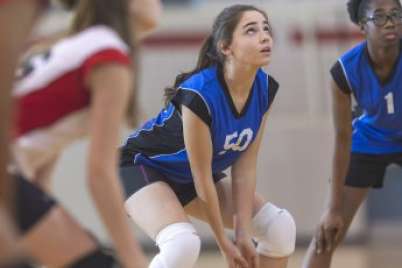
7 tips for parents with daughters in sports
Done right, sports and physical activities are excellent for our children’s physical, mental, and emotional health. However, girls don’t always have an easy experience.
Girls often face special challenges in realizing the benefits of sport and activity. Even if they’re lucky enough to participate in a quality sport program, their experience can be ruined by problems ranging from peer pressure and body image to physical health challenges.
What can parents do to ensure the best experience for their daughters? Keep in mind the following tips.
1. Find a quality program
Whether your daughter is playing a sport like soccer or tennis or doing an activity such as dance, look for a quality program that features good coaching and instruction. According to Keeping Girls in Sport, one of the main reasons that girls leave sport and activity is lack of fun, and two key reasons for lack of fun are negative coaching and bad group dynamics (more on these issues below).
2. Address negative coaching
Some coaches want to win at all costs. Others simply have a confused sense of how to create motivation. Whatever the reason, some coaches behave like bullies by yelling abuse at their own athletes. This kind of negative coaching causes many girls to quit sports.
If you discover that your daughter is being subjected to a lot of negative coaching, take time to talk with her at home and see how she feels about it. Depending on her response, you might then decide to talk with the coach, team manager, or club administration, or you might choose to remove her entirely from the activity and find another program elsewhere.
3. Consider the peer group
It’s not uncommon to have social cliques within group activities, and sometimes they can be destructive. If your daughter’s sport team or activity has a negative group dynamic, this can lead to feelings of isolation and lessened confidence.
Pay attention to any strange social dynamics that you might notice in your daughter’s activity. Then take time to talk with her at home to see if the dynamics are an issue for her. If they are, both of you need to discuss whether or not she wants to quit the activity or address the problem another way.
4. Ensure good nutrition
Athletes need food to maintain their bodies. Girls who are training and competing intensely require adequate protein to rebuild their muscles, complex carbohydrates to replenish muscle glycogen, healthy fats (omega 3) to maintain cognitive function, and essential minerals and vitamins to maintain just about every physiological system you can name.
Problems arise when girls feel pressured to lose weight due to body image or perceptions around being “lean and mean” for competition. These sorts of pressures often lead to disordered eating and an unhealthy complex of conditions known as relative energy deficiency in sport (RED-S).
The solution is relatively simple. Watch for any signs that your daughter is avoiding eating, or eating inadequately, and especially watch for disrupted menstruation, which is often a sign of RED-S in female athletes. Again, talk with your daughter if you have concerns around her nutrition and eating habits, and involve your family doctor or a counsellor if necessary.
5. Watch for injuries
It has been estimated that female athletes experience between two and eight times the rate of anterior cruciate ligament (ACL) injury as males. Research has suggested a number of reasons, such as changing hormones during adolescence, widening of the hips, and smaller ACLs. The most popular theory suggests that neuromuscular factors are the biggest problem—failure to engage the right muscles while decelerating, changing direction, and landing while running and jumping. Special warm-up and training programs have been developed to address this.
What are the early signs of ACL problems? Often girls will start to experience chronic pain in their knees after training or competition if their ACLs are consistently overstressed. In these instances, the simple solution is rest and recovery until the pain subsides, then continued monitoring to ensure training and competition “loads” (intensity and duration) are not causing her renewed pain. If they are, the intensity and duration of her training and competition should be reduced to avoid overstress. Talk with your daughter’s coach or instructor and make sure everyone is on the same page for her health and well-being.
6. Don’t forget school studies
Your daughter might be a great athlete or performance artist, but she needs an education. Make sure that she doesn’t neglect her school studies for the sake of training and competition. Coaches sometimes forget their athletes have schooling demands, and the problem is worse if your daughter is involved in multiple sports and activities or multiple teams. Check with her regularly to make sure she’s keeping up with her school work, and be ready to talk with her coaches or teachers if you sense they are putting unrealistic demands on her.
7. Cultivate a growth mindset
Some athletes have especially high expectations for themselves. They can experience significant stress and anxiety if they feel they aren’t meeting their goals for performance and achievement as fast as they would like. If this describes your daughter, talk with her about cultivating a growth mindset. Growth and development in any endeavour take time. Nothing happens overnight. With appreciation for the long-term nature of learning and achievement, your daughter will go farther and experience much less anxiety in the process.
Keeping our daughters healthy
It’s well-known that adolescent girls quit sport and activity at a higher rate than boys. We can provide our daughters with all kinds of programs and opportunities to participate, but these won’t serve them if they are getting injured, eating insufficiently, or suffering negative coaching and bad peer relations. By following the tips above, you can help to make your daughter’s path in sport and activity the fun and fulfilling experience that it should be.





